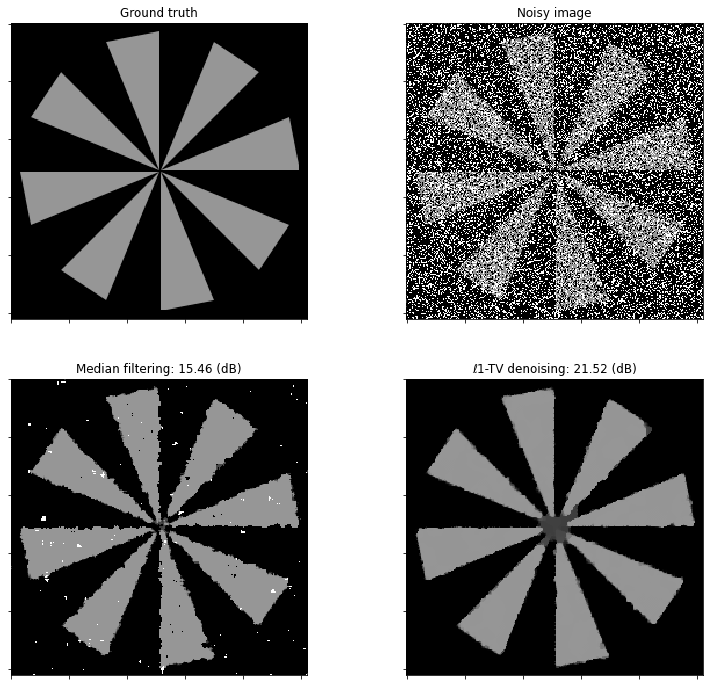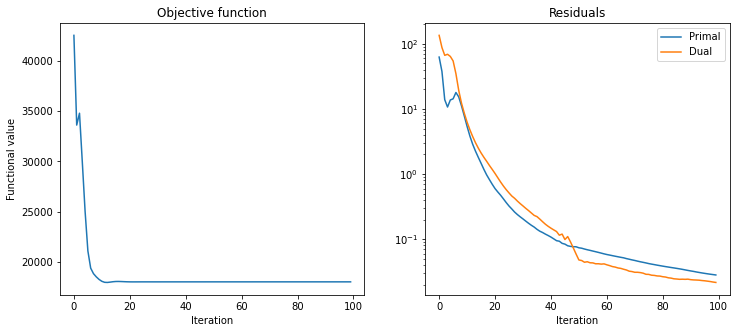ℓ1 Total Variation Denoising#
This example demonstrates impulse noise removal via ℓ1 total variation [2] [20] (Sec. 2.4.4) (i.e. total variation regularization with an ℓ1 data fidelity term), minimizing the functional
\[\mathrm{argmin}_{\mathbf{x}} \; \| \mathbf{y} - \mathbf{x}
\|_1 + \lambda \| C \mathbf{x} \|_{2,1} \;,\]
where \(\mathbf{y}\) is the noisy image, \(C\) is a 2D finite difference operator, and \(\mathbf{x}\) is the denoised image.
[1]:
from xdesign import SiemensStar, discrete_phantom
import scico.numpy as snp
from scico import functional, linop, loss, metric, plot
from scico.examples import spnoise
from scico.optimize.admm import ADMM, LinearSubproblemSolver
from scico.util import device_info
from scipy.ndimage import median_filter
plot.config_notebook_plotting()
Create a ground truth image and impose salt & pepper noise to create a noisy test image.
[2]:
N = 256 # image size
phantom = SiemensStar(16)
x_gt = snp.pad(discrete_phantom(phantom, N - 16), 8)
x_gt = 0.5 * x_gt / x_gt.max()
y = spnoise(x_gt, 0.5)
Denoise with median filtering.
[3]:
x_med = median_filter(y, size=(5, 5))
Denoise with ℓ1 total variation.
[4]:
λ = 1.5e0
g_loss = loss.Loss(y=y, f=functional.L1Norm())
g_tv = λ * functional.L21Norm()
# The append=0 option makes the results of horizontal and vertical finite
# differences the same shape, which is required for the L21Norm.
C = linop.FiniteDifference(input_shape=x_gt.shape, append=0)
solver = ADMM(
f=None,
g_list=[g_loss, g_tv],
C_list=[linop.Identity(input_shape=y.shape), C],
rho_list=[5e0, 5e0],
x0=y,
maxiter=100,
subproblem_solver=LinearSubproblemSolver(cg_kwargs={"tol": 1e-3, "maxiter": 20}),
itstat_options={"display": True, "period": 10},
)
print(f"Solving on {device_info()}\n")
x_tv = solver.solve()
hist = solver.itstat_object.history(transpose=True)
Solving on GPU (NVIDIA GeForce RTX 2080 Ti)
Iter Time Objective Prml Rsdl Dual Rsdl CG It CG Res
-----------------------------------------------------------------
0 2.33e+00 4.255e+04 6.265e+01 1.351e+02 0 0.000e+00
10 2.94e+00 1.807e+04 5.394e+00 6.268e+00 8 9.359e-04
20 3.09e+00 1.802e+04 5.985e-01 1.021e+00 5 5.799e-04
30 3.22e+00 1.802e+04 2.047e-01 3.239e-01 3 6.929e-04
40 3.31e+00 1.802e+04 1.077e-01 1.476e-01 2 7.048e-04
50 3.38e+00 1.802e+04 7.378e-02 4.794e-02 1 9.994e-04
60 3.44e+00 1.802e+04 5.815e-02 4.041e-02 1 9.447e-04
70 3.51e+00 1.802e+04 4.710e-02 3.101e-02 1 8.223e-04
80 3.58e+00 1.802e+04 3.855e-02 2.652e-02 1 7.110e-04
90 3.64e+00 1.802e+04 3.254e-02 2.390e-02 1 6.308e-04
99 3.70e+00 1.802e+04 2.821e-02 2.166e-02 1 5.759e-04
Plot results.
[5]:
plt_args = dict(norm=plot.matplotlib.colors.Normalize(vmin=0, vmax=1.0))
fig, ax = plot.subplots(nrows=2, ncols=2, sharex=True, sharey=True, figsize=(13, 12))
plot.imview(x_gt, title="Ground truth", fig=fig, ax=ax[0, 0], **plt_args)
plot.imview(y, title="Noisy image", fig=fig, ax=ax[0, 1], **plt_args)
plot.imview(
x_med,
title=f"Median filtering: {metric.psnr(x_gt, x_med):.2f} (dB)",
fig=fig,
ax=ax[1, 0],
**plt_args,
)
plot.imview(
x_tv,
title=f"ℓ1-TV denoising: {metric.psnr(x_gt, x_tv):.2f} (dB)",
fig=fig,
ax=ax[1, 1],
**plt_args,
)
fig.show()

Plot convergence statistics.
[6]:
fig, ax = plot.subplots(nrows=1, ncols=2, figsize=(12, 5))
plot.plot(
hist.Objective,
title="Objective function",
xlbl="Iteration",
ylbl="Functional value",
fig=fig,
ax=ax[0],
)
plot.plot(
snp.vstack((hist.Prml_Rsdl, hist.Dual_Rsdl)).T,
ptyp="semilogy",
title="Residuals",
xlbl="Iteration",
lgnd=("Primal", "Dual"),
fig=fig,
ax=ax[1],
)
fig.show()
